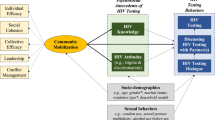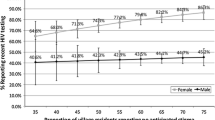Abstract
Despite efforts to increase HIV testing in the African region, the proportion of men who report ever having been tested for HIV remains low. Research has focused on individual level determinants of women’s testing however little is known about factors associated with men’s testing behavior. This analysis investigates community influences on HIV testing among men ages 15–54, using Demographic and Health Survey (DHS) data from Chad, Ghana, Malawi, Nigeria, Tanzania, Uganda, Zambia, and Zimbabwe. Multilevel models were fitted in each country for the outcome of ever receiving an HIV test. After controlling for individual and household level factors, community level factors of demographics, economics, and behavior and knowledge remain significantly associated with HIV testing among men. The results of this analysis highlight the need to recognize the impact of community influences on men’s HIV test seeking behavior, and to harness these community factors in the design of programs aimed at encouraging the uptake of HIV testing among men in Africa.

Similar content being viewed by others
References
WHO. Towards universal access: scaling up priority HIV/AIDS interventions in the health sector, progress report 2009. Geneva, Switzerland: World Health Organization; 2009.
Boxall EH, Smith N. Antenatal screening for HIV; are those who refuse testing at higher risk than those who accept testing? J Public Health (Oxf). 2004;26(3):285–7.
Cartoux M, Meda N, Van de Perre P, Newell ML, de Vincenzi I, Dabis F. Acceptability of voluntary HIV testing by pregnant women in developing countries: an international survey. Ghent International Working Group on Mother-to-Child Transmission of HIV. AIDS. 1998;12(18):2489–93.
Jereni BH, Muula AS. Availability of supplies and motivations for accessing voluntary HIV counseling and testing services in Blantyre, Malawi. BMC Health Serv Res. 2008;8:17.
Smith DJ. Modern marriage, men’s extramarital sex, and HIV risk in southeastern Nigeria. Am J Public Health. 2007;97(6):997–1005.
Dunkle KL, Stephenson R, Karita E, Chomba E, Kayitenkore K, Vwalika C, et al. New heterosexually transmitted HIV infections in married or cohabiting couples in urban Zambia and Rwanda: an analysis of survey and clinical data. Lancet. 2008;371(9631):2183–91.
Pulerwitz J, Izazola-Licea JA, Gortmaker SL. Extrarelational sex among Mexican men and their partners’ risk of HIV and other sexually transmitted diseases. Am J Public Health. 2001;91(10):1650–2.
Amaro H. Love, sex, and power. Considering women’s realities in HIV prevention. Am Psychol. 1995;50(6):437–47.
Corbett EL, Dauya E, Matambo R, Cheung YB, Makamure B, Bassett MT, et al. Uptake of workplace HIV counselling and testing: a cluster-randomised trial in Zimbabwe. PLoS Med. 2006;3(7):e238.
Mugisha E, van Rensburg GH, Potgieter E. Factors influencing utilization of voluntary counseling and testing service in Kasenyi fishing community in Uganda. J Assoc Nurses AIDS Care. 2010;21(6):503–11.
Castle S. Doubting the existence of AIDS: a barrier to voluntary HIV testing and counselling in urban Mali. Health Policy Plan. 2003;18(2):146–55.
Morin SF, Khumalo-Sakutukwa G, Charlebois ED, Routh J, Fritz K, Lane T, et al. Removing barriers to knowing HIV status: same-day mobile HIV testing in Zimbabwe. J Acquir Immune Defic Syndr. 2006;41(2):218–24.
Creek TL, Ntumy R, Seipone K, Smith M, Mogodi M, Smit M, et al. Successful introduction of routine opt-out HIV testing in antenatal care in Botswana. J Acquir Immune Defic Syndr. 2007;45(1):102–7.
Rennie S, Behets F. Desperately seeking targets: the ethics of routine HIV testing in low-income countries. Bull World Health Organ. 2006;84(1):52–7.
Mbago MC. Socio-demographic correlates of desire for HIV testing in Tanzania. Sex Health. 2004;1(1):13–21.
Peltzer K, Matseke G, Mzolo T, Majaja M. Determinants of knowledge of HIV status in South Africa: results from a population-based HIV survey. BMC Public Health. 2009;9:174.
Venkatesh KK, Madiba P, De Bruyn G, Lurie MN, Coates TJ, Gray GE. Who gets tested for HIV in a South African urban township? Implications for test and treat and gender-based prevention interventions. J Acquir Immune Defic Syndr. 2011;56(2):151–65.
Ayenew A, Leykun A, Colebunders R, Deribew A. Predictors of HIV testing among patients with tuberculosis in North West Ethiopia: a case-control study. PLoS ONE. 2010;5(3):e9702.
Weiser SD, Heisler M, Leiter K. Percy-de Korte F, Tlou S, DeMonner S, et al. Routine HIV testing in Botswana: a population-based study on attitudes, practices, and human rights concerns. PLoS Med. 2006;3(7):e261.
Jewkes R, Dunkle K, Nduna M, Levin J, Jama N, Khuzwayo N, et al. Factors associated with HIV sero-status in young rural South African women: connections between intimate partner violence and HIV. Int J Epidemiol. 2006;35(6):1461–8.
Maman S, Mbwambo JK, Hogan NM, Weiss E, Kilonzo GP, Sweat MD. High rates and positive outcomes of HIV-serostatus disclosure to sexual partners: reasons for cautious optimism from a voluntary counseling and testing clinic in Dar es Salaam, Tanzania. AIDS Behav. 2003;7(4):373–82.
Kalichman SC, Simbayi LC. HIV testing attitudes, AIDS stigma, and voluntary HIV counselling and testing in a black township in Cape Town, South Africa. Sex Transm Infect. 2003;79(6):442–7.
Obermeyer CM, Osborn M. The utilization of testing and counseling for HIV: a review of the social and behavioral evidence. Am J Public Health. 2007;97(10):1762–74.
Bwambale FM, Ssali SN, Byaruhanga S, Kalyango JN, Karamagi CA. Voluntary HIV counselling and testing among men in rural western Uganda: implications for HIV prevention. BMC Public Health. 2008;8:263.
Diez-Roux A. Investigating neighborhood and area effects on health. Am J Public Health. 2001;91(11):1783–9.
Diez-Roux AV. Bringing context back into epidemiology: variables and fallacies in multilevel analysis. Am J Public Health. 1998;88(2):216–22.
Duncan C, Jones K, Moon G. Context, composition and heterogeneity: using multilevel models in health research. Soc Sci Med. 1998;46(1):97–117.
DiPrete TA, Forristal JD. Multilevel models: methods and substance. Ann Rev Sociol. 1994;20:331–57.
Hutchinson PL, Mahlalela X, Yukich J. Mass media, stigma, and disclosure of HIV test results: multilevel analysis in the Eastern Cape, South Africa. AIDS Educ Prev. 2007;19(6):489–510.
Kranzer K, McGrath N, Saul J, Crampin AC, Jahn A, Malema S, et al. Individual, household and community factors associated with HIV test refusal in rural Malawi. Trop Med Int Health. 2008;13(11):1341–50.
Beaudoin CE. HIV prevention in sub-Saharan Africa: a multilevel analysis of message frames and their social determinants. Health Promot Int. 2007;22(3):198–206.
Gabrysch S, Edwards T, Glynn JR. The role of context: neighbourhood characteristics strongly influence HIV risk in young women in Ndola, Zambia. Trop Med Int Health. 2008;13(2):162–70.
Msisha WM, Kapiga SH, Earls FJ, Subramanian SV. Place matters: multilevel investigation of HIV distribution in Tanzania. AIDS. 2008;22(6):741–8.
Johns MM, Bauermeister JA, Zimmerman MA. Individual and neighborhood correlates of HIV testing among african american youth transitioning from adolescence into young adulthood. AIDS Educ Prev. 2010;22(6):509–22.
Babalola S. Readiness for HIV testing among young people in northern Nigeria: the roles of social norm and perceived stigma. AIDS Behav. 2007;11(5):759–69.
Guo G, Zhao H. Multilevel modeling for binary data. Annual Review of Sociology. 2000;26:441–62.
Pickett KE, Pearl M. Multilevel analyses of neighbourhood socioeconomic context and health outcomes: a critical review. J Epidemiol Community Health. 2001;55:111–22.
Wyrod R. Masculinity and the persistence of AIDS stigma. Cult Health Sex. 2011;13(4):443–56.
Townsend L, Jewkes R, Mathews C, Johnston LG, Flisher AJ, Zembe Y, et al. HIV risk behaviours and their relationship to intimate partner violence (IPV) among men who have multiple female sexual partners in Cape Town, South Africa. AIDS Behav. 2011;15(1):132–41.
Parkhurst JO. Understanding the correlations between wealth, poverty and human immunodeficiency virus infection in African countries. Bull World Health Organ. 2010;88(7):519–26.
Greig FE, Koopman C. Multilevel analysis of women’s empowerment and HIV prevention: quantitative survey. Results from a preliminary study in Botswana. AIDS Behav. 2003;7(2):195–208.
Iyaniwura CA, Oloyede O. HIV testing among youths in a Nigerian local population. West Afr J Med. 2006;25(1):27–31.
Sarna A, Chersich M, Okal J, Luchters SM, Mandaliya KN, Rutenberg N, et al. Changes in sexual risk taking with antiretroviral treatment: influence of context and gender norms in Mombasa, Kenya. Cult Health Sex. 2009;11(8):783–97.
Acknowledgments
This research was funded by the National Institute of Child Health and Human Development, grant number 1R03HD053226-01A1.
Author information
Authors and Affiliations
Corresponding author
Rights and permissions
About this article
Cite this article
Stephenson, R., Miriam Elfstrom, K. & Winter, A. Community Influences on Married Men’s Uptake of HIV Testing in Eight African Countries. AIDS Behav 17, 2352–2366 (2013). https://doi.org/10.1007/s10461-012-0223-0
Published:
Issue Date:
DOI: https://doi.org/10.1007/s10461-012-0223-0




